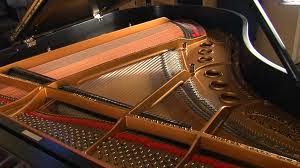One thing that most pianos have in common is the fact that they need to professionally tuned. With exception of digital pianos, virtually all pianos rely on piano tuning to produce optimal sound quality. Below we describe the ways in which pianos are tuned.
Tuning a Piano to Produce the Perfect Sound
The tuning of a piano can be done in various ways, resulting in the production of different sounds based on pitch, tone, and various other elements. There are three main parts that are affected by the varied ways with which the piano can be tuned. These elements include:- The length: It is in relation to the strings that determine the pitch. If all the other factors remain the same but the strings are made shorter, a higher pitch is produced.
- The mass on every unit length: It is considered that a higher pitch is likely to be produced if other factors remain constant but the wires are made thinner.
- Tension: The other major factor that determines the pitch produced by the piano is the tightness of the wire. Thus, the tighter the wire with all other elements being the same will produce a higher pitch.
The tools used to for piano tuning include the tuning hammer, a variety of mutes, and a tuning fork (or in some cases an electronic tuning device can be used.) The tuning hammer is used in order to efficient turn the tuning pins, which increases or decreases the tension of the piano strings.
The variety of mutes that are used mute or disable the idle strings that are not being tuned. While tuning certain octaves of the piano, a felt strip is typically applied over the middle section of the piano as well as inserted between each note, thus muting the outer two strings of each note. As a result, the middle string is free to vibrate and can be tuned accordingly.
Most highly acclaimed piano dealers staff professional piano tuners. One source of piano tuning services with multiple locations found in Georgia, Illinois, Missouri, North Carolina, and Florida is Piano Distributors. The company's Clearwater, FL store is one of the premier sources for all things pianos, including lessons and La Grande Hall which seats 120 people.

No comments:
Post a Comment